The Great Loop – Part II
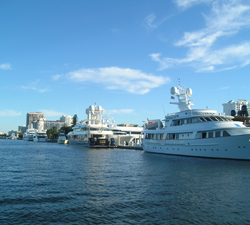
By Lynn Lortie
The big adventure continues!
After ten days in Mobile, sightseeing, doing repairs and stocking up, we put the mast back up and were ready to go. We just needed a good weather report. One great thing about the VHF weather in the USA is that it goes by county. It makes trip planning easier because the forecasts are localized.
Bypassing part of the Gulf Intracoastal Waterway (ICW) because Adamant’s mast was too high for the bridges, we headed to Panama City. We motored in flat calm accompanied by sailfish, sea turtles and dolphins all with their own seemingly choreographed routines. We arrived in Port St. Joe 169 miles and 27 hours later.
After a whole day relaxing in Saul Creek, we headed to Apalachicola – the home port for a variety of seafood workers, including oyster harvesters and shrimpers. In fact, more than 90% of Florida's oyster production is harvested from Apalachicola Bay. Carrabelle, a lovely seaside town was next on our itinerary. Void of streetlights, high rises, four-lane 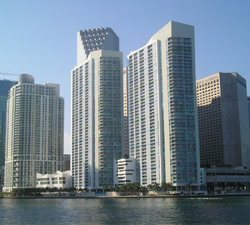 highways, crowded beaches and fast food chains, Carrabelle is truly a haven for peace and tranquility. But eventually, we had to leave.
highways, crowded beaches and fast food chains, Carrabelle is truly a haven for peace and tranquility. But eventually, we had to leave.
10-15 knot winds from the northeast provided Adamant perfect conditions for her first open water crossing to Tarpon Springs. At 6 am, after clearing ice from the deck, we headed out into the Gulf. The wind only lasted three hours so we were forced to motor sail the rest of the way. At sunrise the next day, we entered crab pot heaven. This sea of white bobbers haunted us for the next 300 miles and, sadly, prevented us from visiting Tarpon Springs – Florida’s sponge capital – so we continued down the ICW to Clearwater Beach where we found a small bay and dropped anchor. We had been underway for 30 hours, covering 183 nautical miles. After a badly needed nap, we headed to the beach. From its eggshell white sand to its burnt orange sunsets, Clearwater Beach offers a truly family-friendly seaside vacation spot. If you do go, make sure to visit the Clearwater Marine Aquarium.
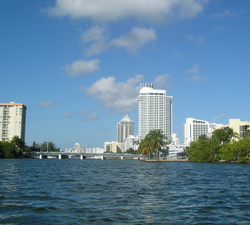 The ICW continued to offer up a fabulous run south. Million dollar homes, pelicans, dolphins and bridges all welcomed us along the way. We ventured ashore at Fort Myers Beach, mostly because we needed to do laundry and get groceries; we stayed one night in Marco Harbor – home to several new and beautiful condo developments.
The ICW continued to offer up a fabulous run south. Million dollar homes, pelicans, dolphins and bridges all welcomed us along the way. We ventured ashore at Fort Myers Beach, mostly because we needed to do laundry and get groceries; we stayed one night in Marco Harbor – home to several new and beautiful condo developments.
En route to Little Shark River, we were treated to another magnificent dolphin display. After the 15-minute show, they disappeared. Shortly after, however, the biggest one returned, hovering on port and forcing us to point to starboard. When we entered the harbour, we realized that we would likely have grounded had he not guided us. What an amazing escort!
After almost 3,000 nautical miles and four months, we finally arrived in the Florida Keys. We entered Marathon Harbor and picked up a mooring ball. We had very strong winds, about 25-30 knots – the most wind we had seen in three weeks. Very tricky!
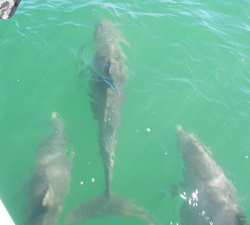 We stayed 17 days. While there, we completed our “fitting out” with 100 feet of galvanized chain (at a bartered price of $4.00/ft.) and a new 100-amp alternator (to speed up battery-charging and provide back-up to our solar panels). We purchased chart books and cruising guides and enough food for three months. We were hoping we’d only need to buy perishables in the Bahamas – our winter destination.
We stayed 17 days. While there, we completed our “fitting out” with 100 feet of galvanized chain (at a bartered price of $4.00/ft.) and a new 100-amp alternator (to speed up battery-charging and provide back-up to our solar panels). We purchased chart books and cruising guides and enough food for three months. We were hoping we’d only need to buy perishables in the Bahamas – our winter destination.
For only $2 each we were able to hop on a bus in Marathon that took us all the way to Key West. This is a place that caters to tourists with all sorts of shops, bars and boutiques. We took the “hop on, hop off” bus and got the guided tour of the area. We did that in many places; it was worth the price to get the history and flavour of the city.
We finally left Marathon and headed northeast to Long Island Key, Rodriguez Key and eventually arrived at No Name Harbor in Miami where we spent three days exploring while waiting for a weather window. When it arrived, the Gulf 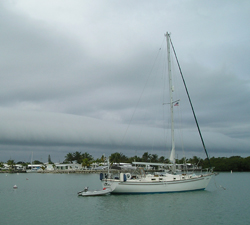 Stream was flat calm and we checked into the Bahamas in Bimini (where the Fountain of Youth was said to have been) at 11:30 the same day. We caught our first glimpse of turquoise waters and sugar white sand. Looking 15 feet down, you can make out every blade of grass and every starfish.
Stream was flat calm and we checked into the Bahamas in Bimini (where the Fountain of Youth was said to have been) at 11:30 the same day. We caught our first glimpse of turquoise waters and sugar white sand. Looking 15 feet down, you can make out every blade of grass and every starfish.
We headed out to cross the Bahamas Banks with eight other sailboats in tow – we always seem to be lead boat! By the time we dropped anchor, we were surrounded by anchor lights. It’s very strange to be out of sight of land, in only 15 feet of water, with a million stars and reflecting on the flat calm waters. We were gone again before dawn and arrived in Nassau that afternoon. We stayed a few days and then headed out to spend the winter exploring the Exumas.
We left the Bahamas earlier than we had originally intended, but only by three weeks. There were a group of boats all heading across the Gulf Stream during a particularly good weather window. We have learned to take help where you can 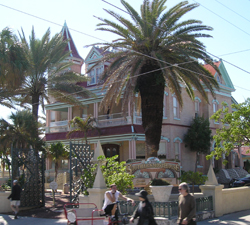 get it and crossing the Gulf Stream with company and in fair weather is a good thing. We arrived back in Fort Lauderdale and began to make our way up the Atlantic ICW.
get it and crossing the Gulf Stream with company and in fair weather is a good thing. We arrived back in Fort Lauderdale and began to make our way up the Atlantic ICW.
We were in awe as we entered the channel into Fort Lauderdale. It is a cruise ship port; many ships were getting ready for their next voyage, including the brand new Oasis Of The Seas! But it was when we entered the ICW that we were struck speechless by the number of private yachts moored at marinas – hundreds of mega yachts all within a five-mile stretch. Many of them sported helicopters on deck.
Once past the marinas, we entered “The Canyon”. It was like travelling through Venice. Enormous homes lined the sides of the canal and most have a yacht tied up out front. However, this is also where we started encountering bridges that had to open for us, as many as 20 in one day. We were also finding it more difficult to find a place to anchor. (There were many marinas, but they were too rich for our budget.) Occasionally, the canals widened and there were areas where 8 or 10 boats could comfortably spend the night, but they were few and far between.
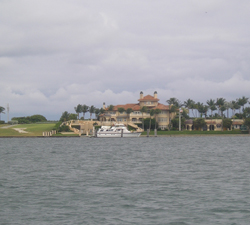 Sometimes we were able to wiggle into a small lake off the channel. They weren’t marked as anchorages, but the chart plotter and our Skipper Bob guidebook gave them enough depth for our 5-foot keel. Those bays were a bonus as we were able to dinghy to shore and walk the beaches on the Atlantic side, a nice treat after days on the boat. We stopped at Vero Beach – referred to as Velcro Beach by cruisers –because once you get there, it’s so hard to leave. The beaches are beautiful, the shopping is fantastic and the restaurants are superb. We have friends who winter there which made our visit even more special.
Sometimes we were able to wiggle into a small lake off the channel. They weren’t marked as anchorages, but the chart plotter and our Skipper Bob guidebook gave them enough depth for our 5-foot keel. Those bays were a bonus as we were able to dinghy to shore and walk the beaches on the Atlantic side, a nice treat after days on the boat. We stopped at Vero Beach – referred to as Velcro Beach by cruisers –because once you get there, it’s so hard to leave. The beaches are beautiful, the shopping is fantastic and the restaurants are superb. We have friends who winter there which made our visit even more special.
We did hate to leave, but Titusville was calling and we were anxious to get there to watch the last night launch of the shuttle. With dozens of other boats around us and hundreds of people lined up on the bridge above us, we all watched the shuttle launch; it was truly one of the most awesome and surprisingly emotional experiences I have ever had. Then the horns and cheers started. It was so clear that night that we were able to watch the booster rockets fall off and plunge into the ocean. We will remember that event for as long as we live.
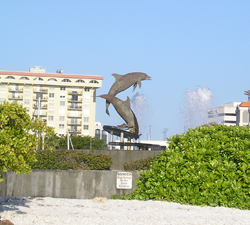 As soon as it was bright, we pulled up the anchor and headed north to Daytona Beach. There were still many bridges to pass through, dolphins to watch and manatees to avoid. However, it was becoming more rural with lots of open sand dunes and cottages on them. Here, the ICW was more like a river and less like a canal. Every day was bright and sunny and that made the miles fly by. There was a lot of traffic heading north. The lead boats would radio back with depths and currents so we could all prepare for shallow or fast-moving water. We stopped for a day in Daytona Beach and took the dinghy ashore to walk the beach. There is nothing like enjoying an ice cream cone while walking bare-footed in the hot sand.
As soon as it was bright, we pulled up the anchor and headed north to Daytona Beach. There were still many bridges to pass through, dolphins to watch and manatees to avoid. However, it was becoming more rural with lots of open sand dunes and cottages on them. Here, the ICW was more like a river and less like a canal. Every day was bright and sunny and that made the miles fly by. There was a lot of traffic heading north. The lead boats would radio back with depths and currents so we could all prepare for shallow or fast-moving water. We stopped for a day in Daytona Beach and took the dinghy ashore to walk the beach. There is nothing like enjoying an ice cream cone while walking bare-footed in the hot sand.
You may have realized by now that we did very little sailing. We were able to motor sail in the open areas, but because of all the bridges and twists and turns, it wasn’t practical or safe to cut the engines. However, no matter what boat you choose to do the Loop in, the sights are the same for all. And the sights kept on coming!
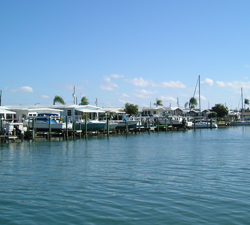 Photo Captions:
Photo Captions:
Photo 1 – Mile after mile of yachts in Fort Lauderdale
Photo 2 – Entering Miami
Photo 3 – Approaching our anchorage in Miami Beach
Photo 4 – Dolphins swimming beside Adamant, off the West Coast of Florida
Photo 5 – We got a storm from this approaching front. Thankfully we were on a mooring ball in Marathon midway up the Florida Keys.
Photo 6 – This house has the distinction of being the most southern house in the US. It's right at the tip of Key West.
Photo 7 – We encountered miles of mega yachts lined up along the canal into Fort Lauderdale.
Photo 8 – Sculpture in Sarasota Park
Photo 9 – The ICW passes right through Venice, Florida and went on for miles like this.




























